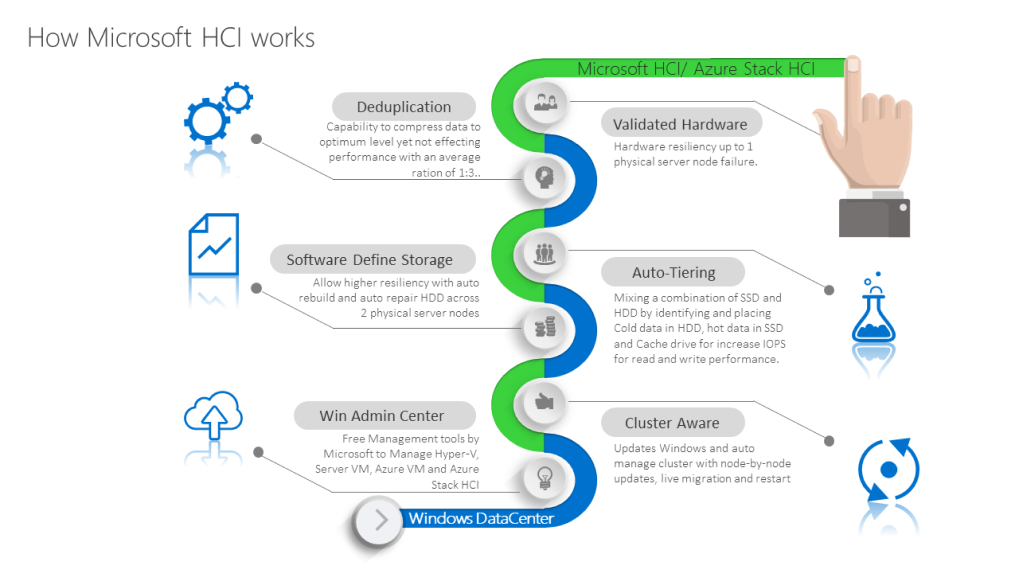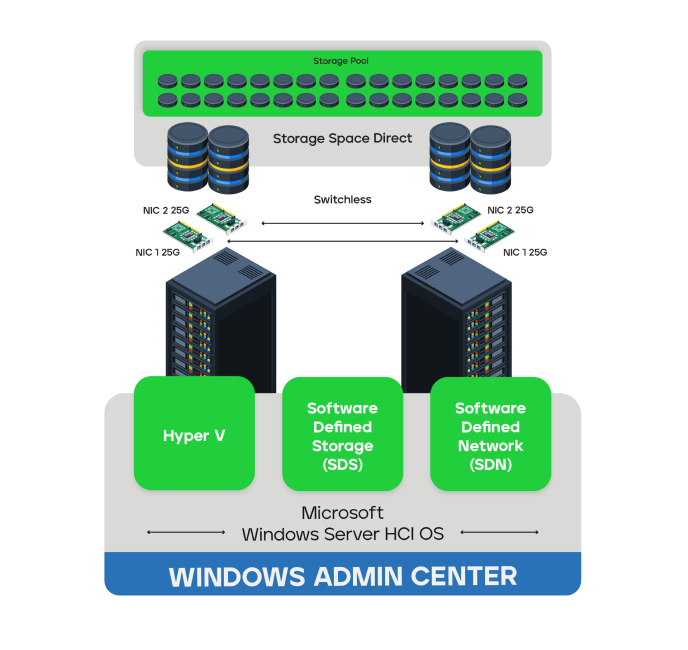What is Microsoft HCI (Hyper-converged infrastructure)?
Microsoft HCI is a hyperconverged infrastructure solution that combines software-defined compute, storage, and networking into one cluster. It provides high-performance, cost-effective, and easily scalable virtualization for Windows and Linux workloads. It can be deployed on a variety of hardware options, from turnkey solutions to validated nodes. It does not require Azure connectivity, but it can integrate with Azure hybrid services for cloud-based monitoring, backup, recovery, and management.

What Can You Do with HCI?
Build a private cloud
Deploy on-premises with lower costs, more control and better security. Choose from multiple hardware possibilities from our certified partners.
Extend to public cloud
Choose an as-a-service option from the largest HCI cloud ecosystem for faster speed of deployment and less time spent managing infrastructure.
Achieve true hybrid cloud
Manage a mix of VM- and container-based applications deployed across a mix of data center, public cloud, and edge environments with VMware hybrid cloud.
Microsoft HCI architecture

Microsoft’s HCI consists of four major components of their Windows Server operating system:
Microsoft Hyper-V as a hypervisor that runs multiple software-only servers on a single bare-metal server. It’s a key component of Microsoft’s HCI solution.
Storage Spaces Direct (S2D) as a software-defined storage that provides either traditional storage area network services for traditional data center solutions or a virtual storage area network that provides services to a HCI in conjunction with Hyper-V. Storage Spaces Direct is a software-defined storage solution that clusters servers with internal storage into a software-defined storage solution. It combines internal storage drives on a cluster of physical servers (2 and up to 16) into a software-defined pool of storage. This storage pool has cache, tiers, resiliency, and erasure coding across columns—all configured and managed automatically. The storage capacity of the cluster can be scaled out by adding more drives or adding more expansion shelves in the cluster node. Storage Spaces Direct automatically onboards the new drives and rebalances the storage pool. It also automatically uses the fastest storage media present to provide built-in and always-on cache.
Software-defined networking (SDN) as a technology that enables dynamic, programmable, and efficient network configuration and management in data centers. It uses a centralized controller to create, secure, and connect virtual networks and services, such as switching, routing, and load balancing.
Windows Admin Center for VM as a technology that allows you to manage the Windows Server operating system inside a virtual machine from a web browser. It provides a set of essential tools for managing various aspects of the OS, such as certificates, firewall, updates, and more. It also enables you to work with files and run PowerShell commands in the VM without using Remote Desktop or PowerShell.
The benefits of using Microsoft HCI
- It simplifies management, consolidates resources and reduces costs by combining compute, storage, and networking into a single system.
- It enables flexible and scalable virtualization for various workloads such as VDI, remote office operations, and mission-critical applications.
- It reduces the size, weight, and power of the hardware by not using costly storage appliances.
- It increases energy efficiency and improves the effectiveness of IT and system processes.
- It can be designed in a switchless network storage environment.





